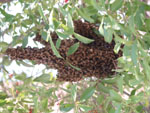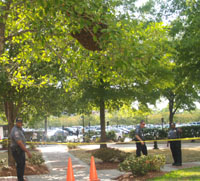MUSC tree home to colony of honey bees
A
swarm of honey bees found a breezy, cooler refuge on the branch of a
tree planted behind the Education Center/Library Building and next to
the ambulance entrance to the Main Hospital ED on June 9. Hundreds of honey
bees swarm in a tree behind the Education Center/Library Building.
Hundreds of honey
bees swarm in a tree behind the Education Center/Library Building.Within a few hours, the bee hive had grown to the size of about two or three footballs, and the University’s Public Safety Department had deployed officers to divert pedestrian traffic away from the mass of bees. By 5 p.m., Public Safety had cordoned off the area with yellow crime tape and blocked the sidewalks with orange barrier cones.
The next morning, the tree was empty and the bees were gone, except for a few stragglers, said Lt. Fred Wanner, a Public Safety Department supervisor.
“The guys on the night shift told me that the honey bees left on their own accord,” Wanner said. “They just took off.”
Wanner said Public Safety will keep tabs on the few that remain in the area and tree.
While honey bees (Apis mellifera) generally are not aggressive, except when they sense a threat to the nest, their sting can be particularly nasty.
“The honey bee’s barbed sting cannot be withdrawn by the insect once it has penetrated the skin,” according to an online report written by Malcolm T. Sanford, Ph.D., an entomology professor with the University of Florida. “The bee’s only means of escape is to tear away part of its abdomen leaving behind the sting with its venom sac attached. The muscles of the sting apparatus continue to pulsate after the bee has flown away, driving the sting deeper into the skin and injecting more venom. For this reason the sting apparatus should be scraped (not pulled) out of the skin as soon as possible after a sting is received.”
 Public Safety's
Pfc. Terrance Major, officer Layne Thompson and Lt. Oneida Banks cordon
off the area around a nest of honey bees.
Public Safety's
Pfc. Terrance Major, officer Layne Thompson and Lt. Oneida Banks cordon
off the area around a nest of honey bees.One percent of the human population is allergic to bee stings, according to the Clemson University Agricultural Extension Service.
A bee sting is always potentially serious, though the severity and duration of a reaction can vary from one person to another, Sanford said. Most persons experience a local non-serious allergic reaction to bee venom. However, depending on the location and number of bee stings received, as well as the present possibility of a severe allergic reaction.
Honey bee removal and relocation should be performed by a licensed beekeeper.
Meanwhile, the honey bee is our most beneficial insect. They are critical in the pollinations of many of fruits and vegetables. In the western United States, honey bees are threatened by the colony collapse syndrome, which is killing billions of precious bees and threatening vast agricultural resources. Clemson is part of a study to determine what is killing honey bees.
Honey bees will defend themselves or their colony if threatened. Don’t disturb a bee colony. If you encounter bees, simply walk away slowly without swatting at the bees, which will irritate them. If under attack by bees, cover your head with your shirt and run quickly through dense vegetation or seek shelter in a vehicle or building. (A mature honey bee colony contains 20,000 to 100,000 bees, depending on the season. The population will peak from late spring to summer and reach a low point in winter.)
Honey bee swarming season normally occurs in South Carolina during the months of May and June, with a few exceptions. During this period, swarms may enter the walls of structures and become a pest problem.
Identifying different bees
Honey bees vary in color from yellow to black, have black or brown bands across the abdomen and are much smaller than a carpenter bee. Honey bees are about 2/3-inch long and covered with hairs or setae. The foraging honey bees have pollen baskets on each hind leg, which will often be loaded with a ball of yellow or dark green pollen. The honey bee is the only stinging insect that can normally winter over as a colony inside the wall of a structure in South Carolina.
The carpenter bee can be identified by having bright yellow, orange or white hairs on the thorax (chest region) and a black shiny abdomen on the dorsal side. Carpenter bees are robust, heavy-bodied bees that range from ¾ to 1-inch in length. These insects bore ½-inch diameter holes that appear to be perfectly round on exterior wooden surfaces.
Yellow jackets lack the dense body hairs that are found on carpenter bees and honey bees. Yellow jackets do not have the pollen baskets on the hind legs. The yellow jacket is about ½ inch long, and the abdomen is characterized by having alternating yellow and black stripes.
For information, contact the Clemson Extension Service at (888) 656-9988; or go to
http://hgic.clemson.edu.
Friday, June 13, 2008
Catalyst Online is published weekly,
updated
as needed and improved from time to time by the MUSC Office of Public
Relations
for the faculty, employees and students of the Medical University of
South
Carolina. Catalyst Online editor, Kim Draughn, can be reached at
792-4107
or by email, catalyst@musc.edu. Editorial copy can be submitted to
Catalyst
Online and to The Catalyst in print by fax, 792-6723, or by email to
catalyst@musc.edu. To place an ad in The Catalyst hardcopy, call Island
Publications at 849-1778, ext. 201.